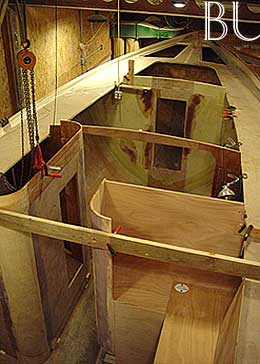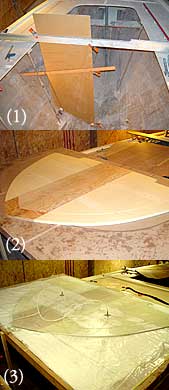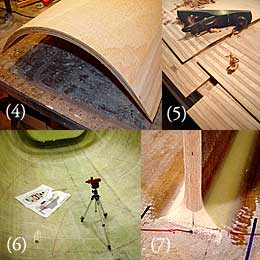


Along the long arc of time it takes to build a boat, there are only a few minutes that can be described as instant gratification. Installing a bulkhead is one. Not only did they make the boat feel like it was starting to taking on my own personality and preferences, but it all happened quickly.
Collision bulkheads in the bow and stern were fabricated out of composites in an effort to keep the weight out of the ends of the boat, while retaining the needed strength. Centrally located bulkheads were fabricated from ¾" oukume plywood and reinforced with a single layer 10 oz. fiberglass cloth. They are tabbed into place with a layer of 6" and 12" wide, 17 oz. biaxial tape, and raised off the hull with Airex spacers (7) to avoid hard spots.
To pattern the bulkheads I used the well documented* "tick stick" method (1). This worked extremely well and seldom were they off more than 3/32" (which, in the age of epoxy fillers, is even better than nothing). The key to success is making sure the tick board is exactly in plane with the intended location of the bulkhead, and that it is securely anchored to the hull before you start taking measurements. What seems as if it might be a complicated procedure at first ended up going very quickly once I got the details worked out.



The composite bulkheads (2 & 3) have a Corcell center and are vacuum bagged with three layers of 17 oz. biaxial per side. The section of plywood core visible in the photo serves as a solid frame to receive a Freeman watertight door. All but a 2" perimeter of this ply will be removed when the door is fit. There is a 1/16" deep recess milled around the entire perimeter of the bulkheads to about 6" in from the edge. This receives the tabbing used to attach the bulkheads to the hull, allowing them to be finished flush before painting.
Two sheets of 3/8" bending ply were laminated together over a mold to form the radiused corners (4), then scarfed to 3/4" oukume. You can see the scarf here along the right edge. The entire bulkhead assembly was then reinforced with 10oz. cloth.
Bulkheads wider than the 48" wide plywood were joined together with a 12:1 ratio scarf (5). On flat sheets I hand cut the scarfs, but for the curved peices I assembled a router jig to mill them out.
The laser level was an indispensable tool for laying out the exact location of bulkheads (6). More than once I stood scratching my head wondering how I would ever have tackled this problem without one. In time I could dimly see it, but every solution I imagined seemed much more time consuming. Thank you Mr. Schawlow and Mr. Townes.
(7) Using a variation of the "bead & cove" technique used in strip planking, I rounded over the edge of the bulkheads and matched that to a bull-nosed slot milled into the Airex spacer. When the assembly is fit tight against the hull, the spacer then adapts freely to the changing hull contours along the perimeter of the bulkhead making for a nice clean joint without a lot of complicated fitting.
* See The Sailors Sketchboook, by Bruce Binghams; Boat Joinery & Cabinetmaking, by Fred Bingham, andUpgrading the Cruising Sailboat, by Danial Spurr.